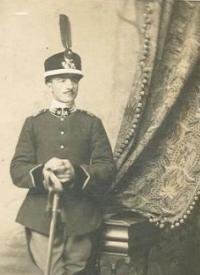 This is some more information that was sent to us by Italy’s Stato Maggiore. It’s a brief overview of the history of the Cavalleggerie di Lucca, translated from the Italian by Guglielmo (Bill) Franchini, and forms part of his research into his grandfather’s connection to this regiment.
This is some more information that was sent to us by Italy’s Stato Maggiore. It’s a brief overview of the history of the Cavalleggerie di Lucca, translated from the Italian by Guglielmo (Bill) Franchini, and forms part of his research into his grandfather’s connection to this regiment.
A brief history of the Lucca Light Cavalry Regiment (16th)
Shortly after the 2nd war of independence on July 23, 1859, a decree of the newly established Tuscan Republic establishes a Light Cavalry Division that named “Cavalleggeri di Lucca” (Lucca Light Cavalry) with headquarters in Pisa. The Corps was made up largely of volunteers and became part of the Army of the League of Central Italy (including the former Papal States of Emilia-Romagna and the Duchy of Tuscany).
On March 18th 1860, the regiment was absorbed into the Sardinian Army (the army of the not yet established kingdom of Italy) that became the Italian Army on the 4th of May 1861 (The date of the unification of Italy under the kingdom of Sardinia and Piedmont).
The regiment participated in the Turkish-Italian war in Libya (1911-1912) with two squadrons, the 6th and the 7th, constituted specifically for this operation.
At the dawn of the Great War (1915) the regiment was reorganized into two groups; the 1st consisting of three squadrons (of cavalry) and the 2nd of two squadrons (of cavalry) and a regimental machine gun group. In 1916 the 1st squadron group was dismounted and fought in the trenches with the 6th squadron of the Treviso Light Cavalry.
Following the reduction of the Cavalry divisions in 1919, the 2nd squadron group changed name to Padova Light Cavalry (Cavalleggeri di Padova). The regiment was finally disbanded on in 1920 and its traditions (colours, medals etc.) entrusted for safekeeping to the “Guides” Light Cavalry regiment (Cavalleggeri Guide).
The regiment was temporarily reconstituted in 1943 as the Lucca Light Cavalry Motorized Regiment (Reggimento Motorizzato Cavalleggeri di Lucca) and became part of the Ariete Armoured Cavalry Division.
The unit was finally disbanded on the 12th of September 1943 following the armistice and after having taken part in the defense of Rome.
See index at:






in upper silesia 1921 during the plebiscite interallied mission was as adjutant of major invrea in ratibor the nobile franchini (in the sources without the name) – perhaps it is the same person?
Thank you Sebastian
I believe that the Franchini you mention cannot be my grandfather because at the time he lived in Milano, but there may be some other relationship with my family.
Can you send me more information?
What language are you most comfortable with? I used to speak German, I forgot most of it but with the help og Google Translator I believe I can try and write in German again.
Bye for now and thanks
Bill
hi,
I wonder if he was Antonio or Gianantonio franchini stappo who was militar and at certain point attaché militaire in some german speaking country at that time. we still have some goods that belonged to his as hunting rifles, german books or other similar items…
hi,
sorry for my late reply. in polish sources/documents I find “nobile franchini” as adjutant of mjr invrea in Ratibor (now Raciborz, Upper Silesia, Poland). But in italian documents, that are few information about Gianantonio Franchini Stappo, tenente, 29. Regg. Artigliera Campagna from Verona – perhaps the same person, what Guido F S means. He was member of “ufficiali” of the Interallied Commission in Upper Silesia. This Commission – with french, british and italian members – prepare the plebiscite in “Alta Slesia”. See: Andreas Kiesewetter, Dokumente zur italienischen Politik in der oberschlesischen Frage 1919-1921, Wuerzburg 2001, p. 125 (to see in googlebooks also). I cannot say, if Franchini from Ratibor and Franchini Stappo the same person is.
best wishes
sebastian
Hi,
I know Gianantonio was in upper slesia and that he was a cousin of mine. As a matter of fact I have object that have his name in it (hunting rifles and similar) and my grandfather told me these oblects are in our, now my, possession because Gianantonio died without descendants. I think it is very likely to be the person in poland
best wishes
guido franchini stappo